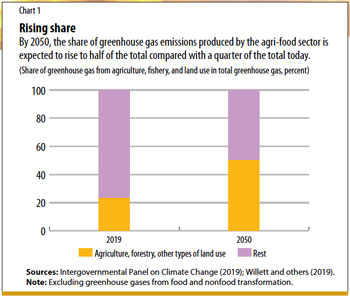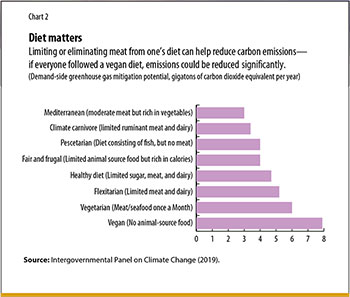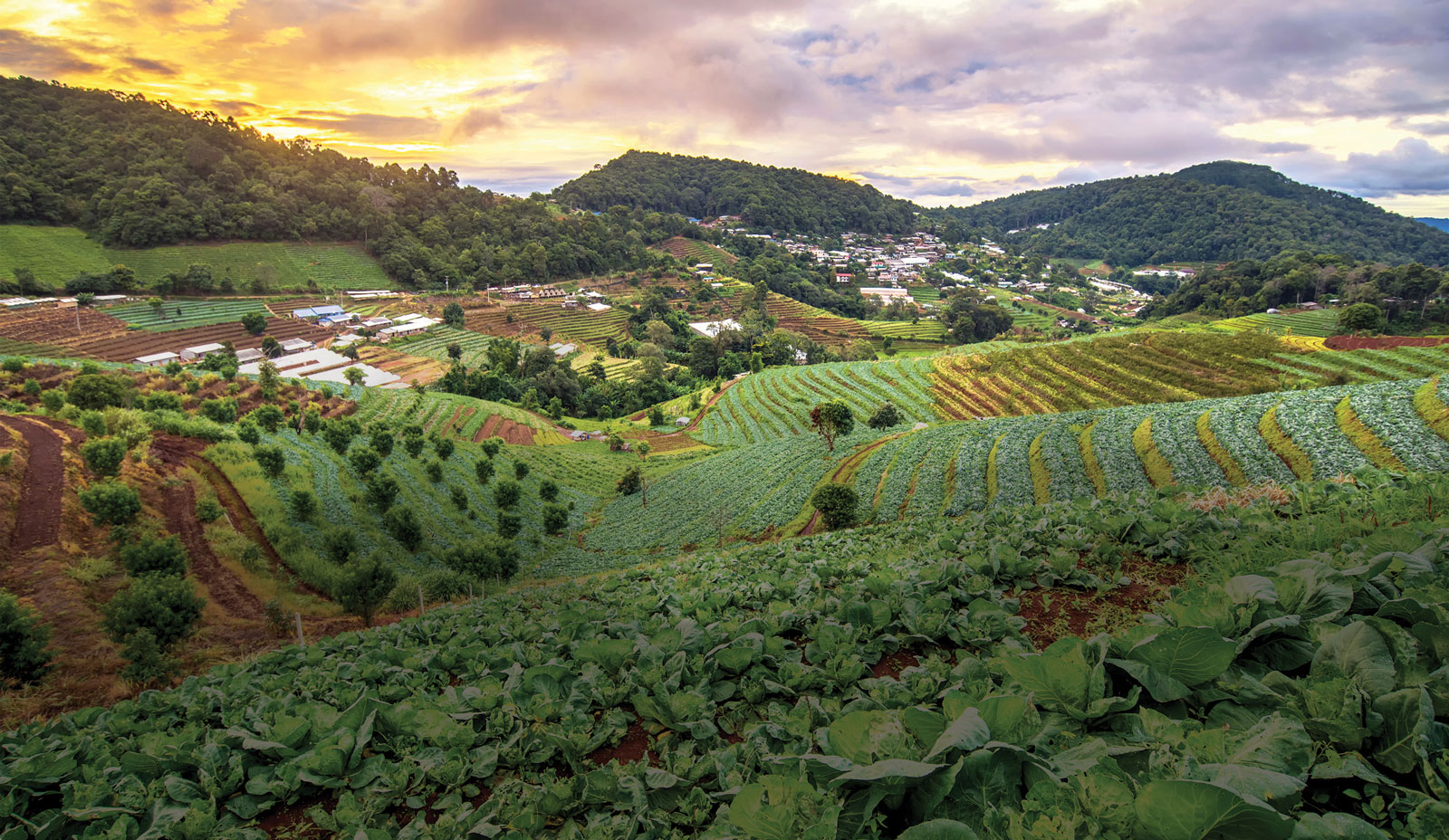Smart changes to how we farm and eat can have a huge impact on our planet
At last year’s World Economic Forum in Davos, Switzerland, delegates spoke of a “Great Energy Transformation” needed to ensure a clean and secure energy future. No less urgent for the future of the planet is what we might call a “Great Food Transformation.”
While the climate implications of burning fossil fuels have received a great deal of attention, recent research by the UN’s Intergovernmental Panel on Climate Change (IPCC) shows that what we eat, how we produce it, and how it gets to us exerts an even greater impact on the global environment and public health. Greening food production and managing food demand are crucial for meeting the UN’s 2030 Agenda for Sustainable Development and the environmental pledge behind the UN’s Paris Agreement.
Hidden costs of food systems
For centuries, agriculture was dominated by family-owned farms raising diversified crops and livestock. Today, in most Group of Twenty advanced and emerging market economies, crop and animal agriculture has become heavily industrialized and reliant on synthetic chemical applications, genetic modification, and deforestation to produce growing amounts of meat, dairy, and eggs, as well as fiber, timber, and biofuels. At sea, high-tech techniques like sonar and equipment like supertrawlers with mechanized nets make it possible to exploit deeper waters at farther-flung locations and capture fish faster than they can reproduce.
In low-income countries, poor farming and fishing practices, over-reliance on non-food crops, and climatic extremes have put communities and biodiversity at great risk. Land clearing leads to the destruction of native forests, soil erosion, and poor harvests. Local fish stocks are regularly ransacked by global commercial fishing vessels. Low sectoral productivity, because of both rising temperatures and abnormal weather events, constrains both income and food security, pushing many farmers and fishers toward poaching or charcoal production to make ends meet.

As a result of all these transformations, the agri-food sector now creates a quarter of human-produced greenhouse gas emissions—a share expected to increase to a half of all such emissions by 2050—while another 8 percent of emissions results from non-food agriculture and deforestation, according to the IPCC’s 2019 Special Report on Climate Change and Land and the EAT-Lancet Commission. (Chart 1). Cows and sheep, a major source of meat and dairy, have an outsized impact because they release methane, one of the most potent greenhouse gases. Livestock account for around 15 percent of the world’s greenhouse gases each year, according to estimates by the UN’s Food and Agriculture Organization. That roughly equals the emissions from all the world’s cars, trucks, airplanes, and ships or, in country terms, from China. Fires set in the Amazon rainforests and central Africa to make room for pasture illustrate the dramatic trade-offs between cattle ranching, biological diversity, and the planet’s eroding ability to absorb human-emitted carbon dioxide.
As the global population grows and more people demand animal products, achieving targets to limit climate change will become harder. Without action, by 2030 the livestock sector alone could account for 37 percent of the emissions allowable to keep warming under the 2°C target, and 49 percent if the temperature goal is 1.5°C, according to estimates by Helen Harwatt of Harvard University.
Beyond its direct impact on climate change, the agri-food sector uses a lot of the planet’s resources, including about half the world’s ice- and desert-free land and three-quarters of its fresh water. Farming depletes these resources because of routine discharges of pollutants, like pesticides, synthetic fertilizers, and manure; discharges of genetically modified organisms and sediment to surface and groundwater; and loss of topsoil as well as salinization and waterlogging of irrigated land. Current farming methods have been found to degrade soil more than 100 times faster than new soil is formed. Agriculture is also the prime cause of earth’s current mass extinction, according to the UN’s Intergovernmental Science-Policy Platform on Biodiversity and Ecosystem Services (2019).
Worst of all, current food systems have failed to fulfill their promise to secure food for humanity. With a third of all food produced going to the more than 70 billion animals farmed every year on land alone, more than 820 million people worldwide went hungry in 2018, according to the Food and Agriculture Organization. Meanwhile, 650 million people were classed as obese and about 2 billion as overweight, because they ate too much of the wrong things.
1.5ºC target for food
Making food systems sustainable for a growing global population is technologically possible but involves a fundamental reconsideration of production and consumption—namely, a Great Food Transformation.
On the supply side, three changes are necessary. First, global production and consumption of red meat (especially beef) and dairy will need to be cut by about 50 percent, through substitution of proteins supplied by plants. Urgent action in the top three beef (United States, Brazil, European Union) and dairy (United States, India, China) producers is key.
Second, a large-scale shift is needed away from conventional monoculture agriculture toward practices that support biodiversity, such as organic and mixed crop-livestock farming, sustainable soil management, and ecosystem restoration. Denmark and the Netherlands were among the first countries to announce ambitious organic transformation plans. Restoring soils with regenerative practices (e.g., planting cover crops and perennials and eliminating monocultures) could lock up as much as 60 tons of carbon in soil and vegetation per acre, thus reducing levels of carbon dioxide in the atmosphere. Rattan Lal of Ohio State University, a leading soil expert, has calculated that “a mere 2 percent increase in the carbon content of the planet’s soils could offset 100 percent of all greenhouse gas emissions.”
Regenerative ocean farming can both sequester carbon and restore ecosystems. According to the World Bank, ocean farming of seaweed and shellfish in an area equivalent to 5 percent of U.S. territorial waters can produce protein equivalent to 2.3 trillion hamburgers and sequester carbon equal to the output of 20 million cars. And farming less than 10 percent of the oceans could absorb all carbon produced in a year globally and produce enough biofuel to power the world, calculates the University of Melbourne’s Tim Flannery.
Third, better land use, such as planting forests and reducing deforestation, will be an integral part of limiting climate change since intact forests sequester twice as much carbon as planted monocultures. A proposed companion pact to the Paris Agreement—a Global Deal for Nature—targets 30 percent of earth to be formally protected and an additional 20 percent designated as climate stabilization areas, by 2030, to hold global temperature increases below 1.5°C.
If sizeable and consistent, these three changes combined can slash emissions, boost carbon sequestration from arable soil, release land for crops and forests, halt biodiversity and pollinator loss, and restore global freshwater resources.

Changes in supply and land use must be accompanied by a shift in diets toward more and more diverse plant-based foods, such as coarse grains, pulses and vegetables, and nuts and seeds. Research published in Nature in 2018 concluded that while undernourished people could actually eat a little more meat and dairy, the average world citizen should eat 50 percent less, an easy-to-remember rule being “no animal products for breakfast or lunch.” Predominantly plant-based diets are key not only for the planet (Chart 2), but also for people, as they slash the risk of cancer, cardiovascular diseases, type 2 diabetes, and obesity.
The role of policy
Well-targeted economic, financial, and trade policies, as well as structural reforms, can go a long way toward delivering these goals. Currently, in many countries, large amounts of taxpayers’ money are spent on subsidies that encourage otherwise unprofitable, unsustainable meat and dairy production predicated on the systematic inhumane treatment of farmed animals, as well as growing monoculture commodity crops for animal feed. (In 2018, total subsidies to agriculture in OECD member countries reached $233 billion, an amount comparable to Greece’s GDP.) Even more taxpayers’ money then goes to fixing the resulting problems: water and air pollution, animal-borne pandemics, anti-microbial resistances, and the impacts of unhealthy diets. Subsidies for unsustainable farming in advanced economies also discourage private investment in agriculture in developing economies, leaving their consumers dependent on imported food and exposed to volatile international food prices.
These subsidies should be redirected toward sustainable farms producing plant-based protein for human consumption and toward incentives for innovation on alternative proteins and smart farming technologies. Transitional technical and financial assistance, including direct loans, guarantee schemes, crop insurance, and measures to improve land and market access, should be provided to help farmers transition to organic practice. Currently a mere 1.2 percent of global agricultural land is farmed organically, a figure expected to reach only 3.2 percent by 2024 under current policies.
In developing economies, replacing production subsidies with ecological payments to sustainable farmers could reorient industrial agriculture, adding to the climate mitigation potential, while reducing negative impacts on farm incomes. Focusing efforts on women farmers and indigenous people and enhancing local and community collective action is particularly effective, according to researchers at the University of Colorado at Boulder.
Also needed are measures to foster aggressive conservation. These could include land tenure legislation and financial and labor market incentives favoring landowners who protect ecosystems, especially in regions that host the planet’s rainforests. Governments should make the adoption of on-farm conservation practices a condition for receiving farm subsidies. At the international level, a fund could be set up to compensate countries for forgoing trade in commodities whose production threatens critical ecosystems. Similar funds could be established to create new or enforce existing marine conservation areas in critical ecosystems zones, on the blueprint of the conservation successes of the Chilean and Argentinian governments in creating marine parks in the Patagonian sea.
Climate-smart technologies and practices are emerging, including methods to expand biomass energy production from crop and food wastes, manure management, renewable energy-based farming systems, solar- or wind-powered water pumping, drip irrigation, innovative greenhouse technologies, and efficient field machinery. Still critically needed are additional public-private early warning systems for weather, crop yields, and seasonal climate events and public support for innovation in sustainability-enhancing agricultural technology.
Just as carbon tax proposals aim to reduce the carbon footprint of the energy sector, taxes levied on “unsustainable” and “unhealthy” foods—notably meat, dairy, and ultra-processed food—could discourage their overconsumption, bringing consumption in line with scientific nutritional recommendations. The average US retail price of a Big Mac, for example, is around $5.60. But with all the hidden expenses of meat production (including health care, subsidies, and environmental losses) the full burden on society is a hefty $12 per sandwich—a price that, if actually charged, could more than halve the US demand for burgers, according to estimates by David Robinson Simon, author of the 2014 book Meatonomics. Likewise, a gallon of milk would run $9 instead of $3.50 and a store-bought, two-pound package of pork ribs would jump from $12 to $32. Offsetting these taxes with lower taxes on sustainable foods would ensure that consumers’ food purchasing power would not be diminished, while health and environmental gains would still save the United States tens of billions of dollars in net terms every year.
Public policies should also be used to cut food waste. Better supply chain management to limit food rotting in the field, e-commerce platforms sharing real-time information about surplus and demand, smaller retail portions, greater use of frozen food, donations programs for unused food, educational campaigns to build waste consciousness, and reducing excess consumption can make a tremendous dent in food waste emissions.
On the financial side, changes to prudential regulation to properly account for financial risks of institutions that lend to nonsustainable agri-food firms would provide essential support to a Great Food Transformation. A bolder approach to investment of public funds in assets associated with sustainable land use and steps to expand green and sustainable bond markets could help fund the transition.
Extraordinary co-benefits
It is hard to overstate the planetary benefits of greening the agri-food sector. The IPCC’s 2019 report indicates that by 2050, reforms of crop and livestock activities and agroforestry could mitigate up to a third of all greenhouse-gas emissions, while dietary changes alone could lead to a reduction in emissions equal to the sum of the current annual carbon emissions of the United States and India. The elimination of food waste could cut another 8 10 percent of the world’s carbon emissions. Shifting production and consumption toward plant-based foods would also halt deforestation and enable conservation of critical ecosystems.
For humans and our offspring, beyond securing our planet’s habitability and biological richness, the wins would be comparably vast. The food we eat would be more nutritious, more varied, safer, more humanely raised, and more affordable. We would live longer and healthier lives. Savings from lower health costs—one of the top expenditure categories for governments and households—could stabilize global finances. Labor productivity would rise with fewer work years lost because of ill-health, disability, or early death. Critical progress would be made in eradicating world hunger, income inequality, and social immobility, averting mass migration due to climate change.
Climate health is land and seas’ health is human health is economies’ health. If we can muster the will before it is too late, we can have our nutritious food, thriving economies, and a habitable planet too.
Opinions expressed in articles and other materials are those of the authors; they do not necessarily reflect IMF policy.
References:
Batini, Nicoletta. 2019. “Transforming Agri-Food Sectors to Mitigate Climate Change: The Role of Green Finance.” Quarterly Journal of Economic Research, 88, no. 3: 7-42.
Harwatt, Helen. 2018. “Including Animal to Plant Protein Shifts in Climate Change Mitigation Policy: A Proposed Three-Step Strategy.” Climate Policy 19, no. 5: 533–41.
Intergovernmental Panel on Climate Change (IPCC). 2019. Climate Change and Land: An IPCC Special Report on Climate Change, Desertification, Land Degradation, Sustainable Land Management, Food Security, and Greenhouse Gas Fluxes in Terrestrial Ecosystems. Geneva.
Intergovernmental Science-Policy Platform on Biodiversity and Ecosystem Services (IPBES). 2019. Global Assessment Report on Biodiversity and Ecosystem Services. Bonn, Germany.
Willett, Walter, Johan Rockström, Brent Loken, and others. 2019. “Food in the Anthropocene: The EAT-Lancet Commission on Healthy Diets from Sustainable Food Systems.” Lancet 393 (10170): 447–92.









